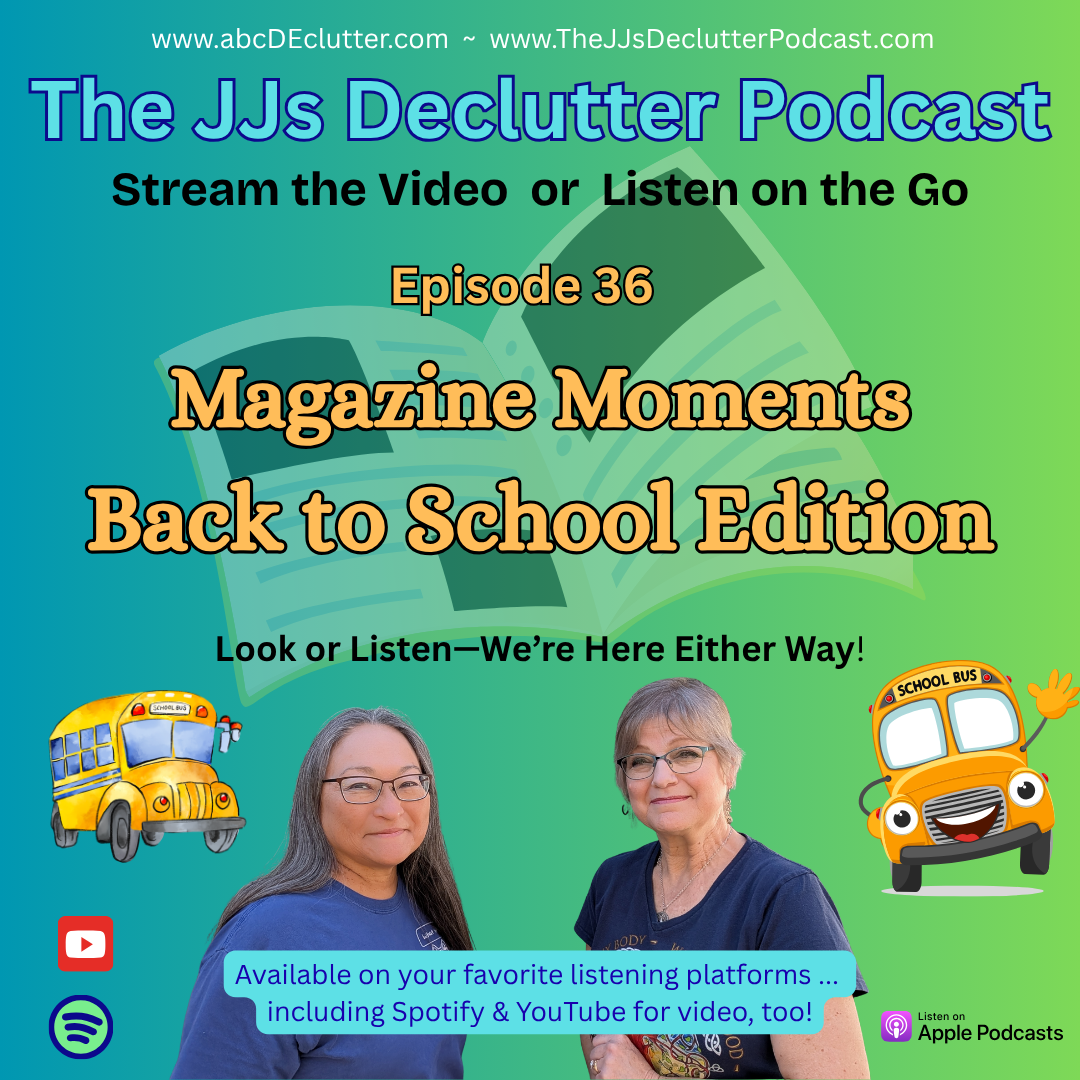Magazine Moments: Back to School Edition - 7 Areas to Tackle Now

Originally aired on The JJ's Declutter Podcast - Episode 36
Hello everyone, and welcome to this month's Magazine Moments! If your house is still in full summer mode and you're dreading the early alarms or drowning in school supply lists, you're not alone. Today we're helping families ease the chaos and clutter of the back-to-school transition with practical strategies that actually work.
Whether you're dealing with reluctant early risers or kids who've been snacking on ice cream for breakfast all summer, we've got you covered. We're breaking down the 7 key areas to tackle now, plus 5 bonus tips for a smoother start to the school year.
1. Reestablishing Routines: The Gradual Reset
Summer throws all your routines out of whack. Kids are staying up late, sleeping in, and treating meal times as mere suggestions. The key to success? Gradual transition, not shock therapy.
The 2-Week Strategy
Start about two weeks before school begins and gradually shift bedtimes earlier by just 10-15 minutes each day. This applies to:
- Bedtimes and wake-up times - Reset those internal clocks slowly
- Meal schedules - Return to structured breakfast, lunch, and dinner times
- Activity rhythms - Begin incorporating focused time periods
Planning After-School Rhythms
Don't forget to plan for after school! Create a predictable flow for:
- Homework time
- Screen time limits
- Dinner preparation
- Chore responsibilities
- Athletics and extracurricular activities
Pro tip: Use visual checklists for younger children. Pictures of each task help non-readers follow routines independently, and kids love checking boxes or earning stickers.
2. Family Calendars and Communication: Getting Everyone on the Same Page
Successful school years require coordination, and coordination requires communication systems that work for everyone.
Centralized Calendar Systems
Choose one primary calendar system—paper, whiteboard, or digital—and make it visible to all family members. Color-code each family member to quickly identify who needs to be where when.
Why paper or whiteboard works: When multiple people need to see information quickly, physical calendars eliminate the "whose phone has the calendar" confusion.
Essential Contact Updates
Before school starts, update and organize:
- Teacher contact information
- School nurse phone numbers
- Emergency contact lists
- Carpool coordination details
Bonus tip: Keep a copy of school schedules on your refrigerator. You'll never again forget about early dismissal days or show up to back-to-school night in your pajamas.
3. Meal Planning and Prep: Avoiding the 7 AM Bread Panic
Mornings become exponentially easier when food decisions are made in advance. The goal isn't gourmet meals—it's consistent, stress-free nutrition.
Night-Before Preparation
- Pack lunches the evening before - Save yourself from morning decision fatigue
- Prep snacks in advance - Portion out grab-and-go options
- Set up breakfast stations - Bowls, spoons, and cereal ready to go
Strategic Menu Planning
Embrace predictable favorites:
- Taco Tuesday means never wondering what's for dinner on Tuesday
- Pizza Friday eliminates end-of-week meal planning stress
- Involve kids in menu selection - Let them choose one meal per week to increase excitement and build responsibility
This isn't about limiting creativity—it's about creating reliable anchors in your weekly schedule.
4. Homework Zones and Supplies: Eliminating Procrastination Excuses
Create a clutter-free homework zone with everything students need within arm's reach. The goal is removing barriers to getting started.
Essential Homework Station Elements
- Dedicated space - Doesn't need to be fancy; a corner of the kitchen table works
- Supply caddy - Pencils, erasers, colored pens, rulers, calculator
- Minimal distractions - No TV, limited screen access, quiet environment
- Emergency backup supplies - Because kids will hide the main supply caddy to avoid homework
The Anti-Procrastination Setup
When everything needed is immediately available, students run out of legitimate excuses for delays. No more "I need to find a pencil sharpener" or "Where are the colored pens?"
Stock up during sales and maintain that emergency backup box. Smart parents always have supplies ready when the main stash mysteriously disappears.
5. Clothes and Laundry: Preventing Morning Wardrobe Battles
Nothing derails a smooth morning faster than clothing conflicts. The solution involves preparation and organization systems that work even during busy weeks.
Advance Planning Strategies
- Lay out outfits the night before - Or better yet, for the entire week
- Complete closet purge - Donate items that don't fit to prevent morning disappointments
- Establish laundry rhythms - Assign specific laundry days or distribute hampers strategically
Organization Systems That Work
Label everything: Drawers or bins for school uniforms, sportswear, socks, and underwear. When family members can quickly locate clean clothes, mornings flow more smoothly.
Special consideration for athletes: Janis shared her system of dedicated plastic drawers in the laundry room for her daughters' soccer gear. Clean practice shirts and team uniforms went directly into labeled drawers, making it each child's responsibility to grab appropriate gear for their bags.
6. Purging and Organizing: Decluttering 101 for School Success
Start fresh by clearing out accumulated summer clutter and establishing systems for school-year paper management.
Priority Decluttering Areas
- Kids' closets - Remove outgrown items and summer-only pieces
- Shoes and backpacks - Clean out and assess condition
- Study spaces - Clear surfaces and organize supplies
Paper Management Systems
Set up individual folders or wall pockets for each child's school papers. Julie's family used wall pocket organizers where each child had their own designated pocket. This created clear accountability: if Mom didn't see important papers, it was because she hadn't checked the system, not because papers weren't properly submitted.
Weekly review prevents accumulation of mystery papers and ensures important communications don't get lost in the shuffle.
7. Miscellaneous Magic: The Safety and Organization Details
These final touches create smooth daily operations and protect your investments in school supplies.
Smart Labeling Strategies
Label everything—backpacks, lunch boxes, water bottles—but label items on the inside, not outside. This crucial safety consideration prevents strangers from reading your child's name and potentially using that information inappropriately.
Modern Tracking Solutions
With expensive water bottles ($40+ becoming common) and valuable electronics, consider adding AirTag locators or similar tracking devices to help recover lost items.
Responsibility Distribution
- Create chore charts so everyone contributes to household functioning
- Develop morning checklists kids can follow independently, even with sleepy eyes
- Establish bedtime preparation routines - Pack backpacks, set out clothes, prepare lunch components
Double-duty checklists: Morning routines get kids out the door smoothly; evening routines prepare for the next day and reduce morning chaos.
2025 Back-to-School Trends and Spending Reality
Current consumer data reveals interesting shifts in how families approach back-to-school shopping:
Spending Patterns
- 3 in 4 shoppers expect to spend the same or more this fall despite economic uncertainty
- 1 in 3 parents anticipate spending even more than 2024
- Technology leads budgets - 1 in 4 parents plan to spend over $500 on tech alone
Shopping Behavior Evolution
Hybrid approaches dominate: Families combine online research and deals with in-store purchases. Interestingly, Gen Z parents show more preference for in-store shopping than millennials or Gen X.
Income influences shopping methods: Households under $75,000 income prefer in-store shopping, while higher earners lean toward online ordering.
Efficiency Strategies
Many families have discovered grocery pickup services save both time and money by avoiding impulse purchases. This same strategic thinking applies to school supply shopping—planned purchases prevent overbuying and budget overruns.
The Big 5 Proactive Steps for Success
1. Gradual Routine Reset
Move bedtimes and wake-up times earlier by 10-15 minutes daily, starting 2-3 weeks before school begins. This prevents shock transitions for both children and parents.
2. Dedicated Study Space Preparation
Get quiet, consistently stocked homework areas ready now. Fancy isn't required—functional is essential.
3. Foster Learning Connections
Link summer activities to school subjects through museum visits, reading together, and finding educational opportunities in daily experiences. Kids learn without realizing they're learning.
4. Early Supply Preparation
Get backpacks ready, label everything appropriately, and check clothing situations before the back-to-school rush.
5. Practice Run Rehearsals
Do complete dry runs: wake up, get dressed, eat breakfast, pack bags, review school routes. Most kids enjoy this "dress rehearsal" approach (teenagers may require different motivation).
Making It Work for Your Family
The key to successful back-to-school transitions isn't perfection—it's consistency and gradual implementation. These strategies work because they:
- Reduce decision fatigue during stressful morning hours
- Create predictable rhythms that decrease family stress
- Establish accountability systems that involve all family members
- Prevent common logistical problems before they derail your day
Avoiding Common Pitfalls
- Don't try to implement everything simultaneously - Choose 2-3 strategies to start
- Involve kids in system creation - They're more likely to follow routines they helped design
- Build buffer time into schedules - Things always take longer than expected
- Have backup plans ready - Emergency supplies, alternate transportation, flexible meal options
Your Action Plan
This week: Choose one area from the seven discussed and implement basic systems.
Next week: Add one additional area while maintaining the first.
Two weeks before school: Have all systems in place and begin routine adjustments.
One week before school: Complete practice runs and final preparations.
Remember: back to school doesn't have to mean back to chaos. With thoughtful planning now, you'll thank yourself later when September mornings flow smoothly instead of feeling like daily crisis management.
The goal isn't creating perfect systems—it's creating sustainable routines that work for your actual family in your real home with your specific schedule constraints.
Keep it simple, keep it intentional, and as always—keep decluttering, especially those summer habits that won't serve you in the school year ahead.
Want to hear Julie and Janis break down all the back-to-school preparation strategies in detail? Listen to Episode 36 of The JJ's Declutter Podcast, where practical family organization meets real-world solutions.
Connect with The JJ's:
- 📺 YouTube: https://www.youtube.com/@abcdeclutterwithjj
- 📸 Instagram: https://www.instagram.com/abcdeclutterwithjj/
- 📘 Facebook: https://www.facebook.com/groups/abcdecluttercommunity
- 🖥️ Website: https://www.abcdeclutter.com/
- 🎙️ Podcast Website: https://www.thejjsdeclutterpodcast.com/
- 🖥️ Email: hello@abcdeclutter.com
What's your favorite back-to-school preparation tip? Share your family's successful strategies with our community!

